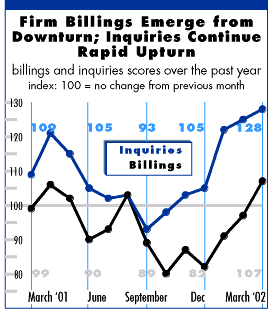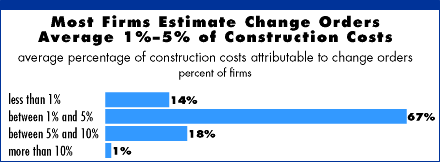
Project change orders account for significant share of construction costs

Work-on-the-Boards Survey
by Kermit Baker, PhD, Hon. AIA
AIA Chief Economist
Billings at U.S. architecture firms declined in September 2001 and have declined further each month since. However . . .
 Inquiries
for new projects continued to increase at a record pace. For each of the
past three months, more than a third of firms have reported a sizeable
increase in new inquiries, while about half of firms report inquiries
holding stable. Only a small share is reporting declines.
Inquiries
for new projects continued to increase at a record pace. For each of the
past three months, more than a third of firms have reported a sizeable
increase in new inquiries, while about half of firms report inquiries
holding stable. Only a small share is reporting declines.
Strong rebound in
the East
Firms in all regions but the West are now reporting healthy gains in billings.
In recent months, there has been a particularly strong rebound among firms
in the East. By area of specialization, residential and institutional
firms are reporting the strongest growth in billings. However, even commercial/industrial
firms reported some improvement in March. Firms in this sector have been
particularly hurt by the recent downturn in the economy.

Like business conditions at architecture firms, the broader economy has shown signs of improvement recently. The employment report for March showed a modest increase in business payrolls, the first increase since last July. However, the national unemployment rate crept back up to 5.7%.
The residential sector has gone through the downturn without missing a beat, and the February numbers continue this trend, with housing starts totaling 1.77 million units (when seasonally adjusted and annualized) and existing home sales totaling 5.88 million units on the same basis. And while the economy is strengthening, inflation remains under control, with consumer prices rising only very modestly and producer prices running below year-ago levels.
Change orders
Change orders remain a chronic issue in the construction industry, and
this month's special question attempted to estimate their magnitude. When
asked to estimate the average percentage of construction costs attributed
to change orders, most firms responded that it was in the 1–5% range.
Of the responding firms, 14% felt that average percentages were below
1% whereas 19% felt that they were above 5%. However, many noted that
it is important to distinguish between changes in scope initiated by the
owner, unforeseen conditions changes initiated by the contractor, and
errors and omissions in the design work.

Single-family residential projects typically were cited as the most frequent construction category for change orders (44% of firms working in this sector indicated that they were very frequent). Three institutional sectors were next in terms of perceived frequency of change orders (health care, transportation, and education), where 22%, 21% and 15% of firms respectively indicated that change orders in these sectors are very frequent.
Copyright 2002 The American Institute of Architects. All rights reserved.
![]()
|
This month, Work-on-the-Boards survey participants are saying: "Our expectation is that the rebound
will be more difficult to achieve than the business press seems
to be indicating." "Many more prospects are before
us since we are aggressively seeking new work." This Just In Baker and Murray to present construction outlook on May 11—click for details. |
|